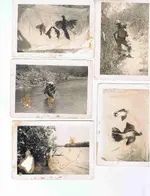9-18-11
Joe in reply to your question, can I read the facsimiles you posted. My answer is I am not fluent in the picture story or the facsimile writing of that area at that time, nor am I fluent in Egyptian hieroglyphs and I am far less so with the facsimiles that preceded and blended with the older cuneiform writing. In these particular fields I piggyback or try to stand on the shoulders of those that leave me in the dust on the common meaning. But on the other hand the facsimiles that precede the Paleo-Hebrew and older forms of Hebrew writing (is clearer to me than some English) which is a close relative to the facsimiles of the Mizraims (which is a parent writing or writing that preceded the writing which we call Egyptian writing today) which we have a lot of in the southwest, but even here in the southwest we have a lot of different types of facsimile or petroglyph writing from different races at different times over a long span of history, which writings are sometimes a blend of different cultures.
There is an old saying that a picture can be worth a thousand words. In ancient times someone that was gifted in writing facsimiles was able to write or carve a picture that portrayed reality that was very real to life and those that were able to perceive that reality comprehended the message that was portrayed in that writing. Let me give you two examples, one in old Hebrew facsimile writing and one in Egyptian writing. The name Jacob in old Hebrew identified what he did at the time he was born, he came out of the womb holding onto the heel of Esau his brother, so he was called heel grabber (Jacob), here in the southwest there is a number of places where this heel grabber is talked about and he is easily recognized if you have a background in the history of his life, his brother was known as the hunter, while he was known as a man of vision.
So when you see facsimiles carved in stone of a foot, with a man holding a bow and arrow, inside the foot, it identifies the foot of a hunter. When you see a hand with an eye in the palm, representing the hand of a visionary man with the fingers wrapped around the heel of the foot, then it is easy to read the story of the heel grabber or Jacob who grabbed the heel of his brother the hunter.
Let’s look at the second example. Most Egyptian scholars would probably say that I was wrong in my interpretation and theirs was right. I am only going to translate Egyptian figures or any other facsimiles of other cultures, where I know by my background of experience, where I am more accurate than they are. Some of the Egyptian scholars will translate that Horace the Falcon Hawk represents the sun that goes from the east to the west. I find that their simple understanding fails to meet its lesser or general meaning nor do they come close to understanding its greater meaning, and I find a number of scholars have made similar mistakes across America. I would agree that most Egyptian and American Scholars on the Mayan and Aztec language are ahead of me in their interpretations of the common meaning in the languages where they are recognized as having made breakthroughs.
When you see Horace the Falcon Hawk with his uplifted wings, the inside of his wings makes a pot, his head that is turned to one side represents the figure that the Hebrew letter that is represented by our R stems from, the sun on top of his head was a symbol they used to represent a great light, it could be of geology such as a flaming volcano or the great light of understanding truth or knowledge, the snake or dragon around the sun identifies it as a dragon or snake sun. In geology a dragon or snake sun is a volcano with lava flows which the ancients identified as fiery snakes or dragons. In Egyptian history Horace was the god of the underworld with one eye, that particular volcano that he represents flowed from the east to the west, and from a distance the center of it looks like a human eye, and he still guards or sits over the entrance to the underworld.
The Greeks called Horace the falcon hawk the one eyed Cyclops, and it is represented on the dollar bill as the All Seeing Eye on the pyramid, to the priest on both sides of the world the greater meaning to this place is where the greater light of truth and knowledge stemmed from. They used the sun to represent the great light of knowledge that went around the world. Both Egyptian and Mayan records identifies that place in the west where the sun or the great light rose in the beginning, both predicted that that sun or great light would rise again in the west, that is why the Aztecs and others took their treasures and records to that place to assist in the accomplishment of such, which included some Jesuit Priests. The treasures of Guadalupe are to help restore the place of Guadalupe, which is the mother of all places, which includes the place that brought forth different types of great lights through some of her sons to the world.
While I am grateful to the foundation or shoulders I have built upon, I don’t intend to limit myself to the tunnel vision that most people have, or to have long drawn out arguments over the common meaning of things they could well whip me on. You could believe that the great and intelligent men really worshiped what we call the sun today, or you could believe that they worshiped the greater light of all truth that the sun symbol represented (symbol of something that enhanced your vision to see more things). There is no doubt that there are many in times past as well as today that bow to the symbol instead of what it represents. They think they can read the past failing to read or understand themselves.
I thank you Joe for giving me an opportunity to make it more clear on what I understand, I was being too general about being able to read petroglyphs in the southwest, not wanting to be specific in giving away a certain area or some other areas where I can read some petroglyphs not knowing any close second to me in certain isolated fields, I could write much upon the subject but will explain a few basic clues, and this will help those that seek them to get to the sacred places of the ancients. Just as a hawk such as Horace had blue and red feathers, so did a volcano have blue and red cinders that flew out of the pot of that volcano having the same characteristics that a falcon hawk has in bringing down it prey by hitting into it like a rock. Some of the ancients used the characteristics of animals and other things to describe the characteristics of things in nature they were talking about. Part of the world referred to this place as the Cauldron or the Black Cooking Pot, Hebrew the U originally represented the pot, and the r the flame coming out of it.
The Hopi talk about some of their ancient heroes visiting the place where the Coyote or the three headed dog of the Greeks guards the underworld, throughout Indian culture this dog is known as the trickster, thousands of people that pass by the place that the Coyote represents, are being fooled or tricked, (due to the great efforts where most of all signs of the civilization that had existed there destroyed or covered) into thinking there is nothing there, not realizing they are walking over the magnificent underworld of the ancients. One of the Hopi trails takes you to the San Francisco Peaks, which they refer to as the great Eagle and from there to the grey hawk and from the grey hawk to the red hawk and from there to the sacred mountain that contains the hard rock kiva of Spiderwoman that the Mexicans identified as Guadalupe, and within a hundred miles you have the mines of Guadalupe that are to help assist or lift a new sun into orbit. That sun is beginning to rise up in the west, and some of us should be able to see it before the end of the Mayan or the Aztecs Calendars. This makes a very long or big story short and I hope comprehendible to some extent.
RW










